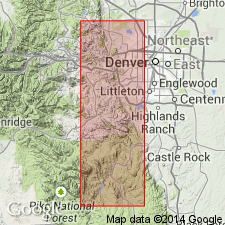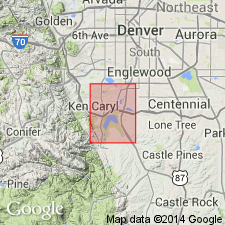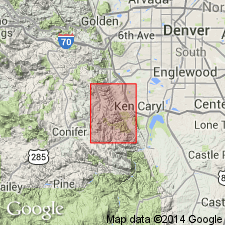
- Usage in publication:
-
- Strain shale member
- Modifications:
-
- Original reference
- Dominant lithology:
-
- Shale
- Mudstone
- Sandstone
- AAPG geologic province:
-
- Denver basin
Summary:
Pg. 31, 42-44, fig. 7. Strain shale member of Lykins formation. Red arenaceous shales and mudstones and fine argillaceous red sandstones with the shales and mudstones predominating. Thickness ranges from 290 to 320 feet. Overlies Glennon limestone member (new); underlies Ralston formation (new). Age is Triassic.
Named from Strain Gulch, which enters Bear Creek just east of town of Morrison, Jefferson Co., north-central CO.
Source: US geologic names lexicon (USGS Bull. 1200, p. 3747).

- Usage in publication:
-
- Strain shale member*
- Modifications:
-
- Mapped 1:24k (Littleton quad, Arapahoe, Douglas, and Jefferson Cos, CO)
- Dominant lithology:
-
- Shale
- Sandstone
- AAPG geologic province:
-
- Denver basin
Summary:
Is Permian? and Triassic? uppermost member of Lykins formation mapped in east-central Jefferson Co, CO (Denver basin). Crops out in valley between hogbacks of Lyons sandstone and Lytle and South Platte formations in southwestern portion of map area. Strain as described by LeRoy (1946, CO Sch. Mines Quart., v.41, no. 2, p. 31) consists of 250 ft of moderate-reddish-brown, silty shale with interbedded thin light-green shale and light-brown sandstone. Overlies Glennon limestone member (Permian?) of Lykins; underlies a light-brown massive fine-grained soft sandstone at top of Lykins that may be correlative with Entrada sandstone which, in turn, underlies Ralston Creek formation. [Uppermost sand not separately mapped; may be included with Strain].
Source: GNU records (USGS DDS-6; Denver GNULEX).

- Usage in publication:
-
- Strain Shale Member*
- Modifications:
-
- Mapped 1:24k (Indian Hills quad, Jefferson Co, CO)
- Dominant lithology:
-
- Shale
- Sandstone
- AAPG geologic province:
-
- Denver basin
Summary:
Is Upper Permian and Triassic? uppermost member of five members of Lykins Formation (Permian and Triassic?) mapped in central Jefferson Co, CO (Denver basin). Outcrops in northeast part of quad in narrow band along Hogback. Conformably overlies Forelle Limestone Member (Upper Permian) of Lykins; unconformably underlies Ralston Creek Formation (Upper Jurassic) [unconformity not shown on Correlation of Map Units]. Map unit described as moderate-yellowish-reddish-brown silty shale; contains interbedded thin light-green shale and light-brown sandstone. About 6 ft of light-brown fine-grained sandstone at top of Lykins may be equivalent to Entrada Sandstone (Upper Jurassic). Thickness about 250 ft.
Source: GNU records (USGS DDS-6; Denver GNULEX).
For more information, please contact Nancy Stamm, Geologic Names Committee Secretary.
Asterisk (*) indicates published by U.S. Geological Survey authors.
"No current usage" (†) implies that a name has been abandoned or has fallen into disuse. Former usage and, if known, replacement name given in parentheses ( ).
Slash (/) indicates name conflicts with nomenclatural guidelines (CSN, 1933; ACSN, 1961, 1970; NACSN, 1983, 2005, 2021). May be explained within brackets ([ ]).

